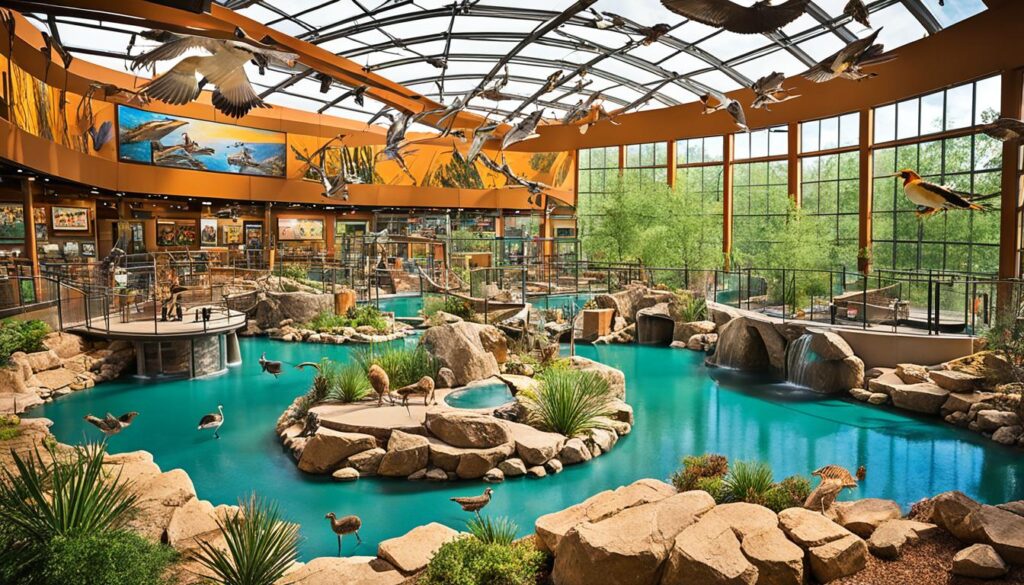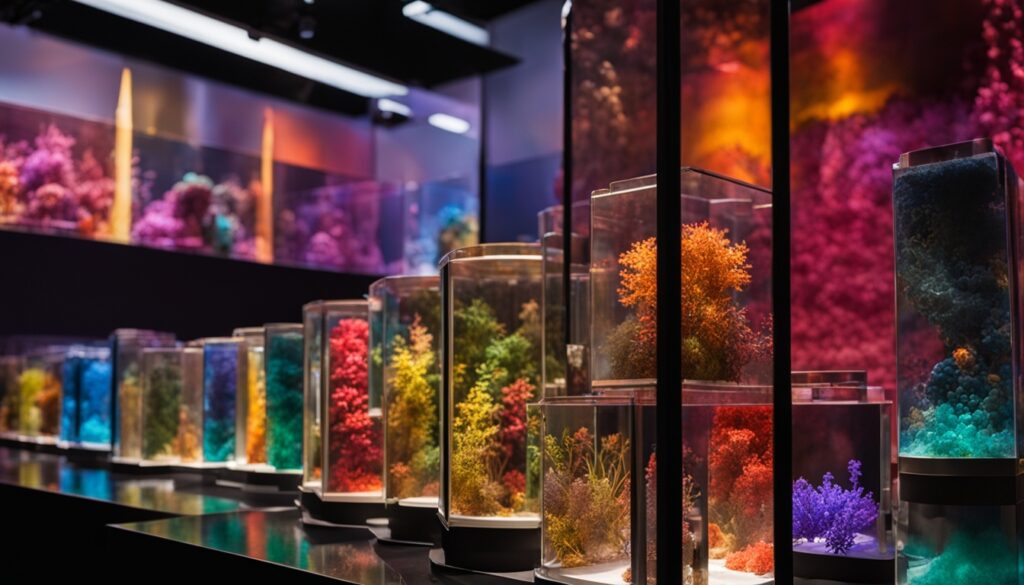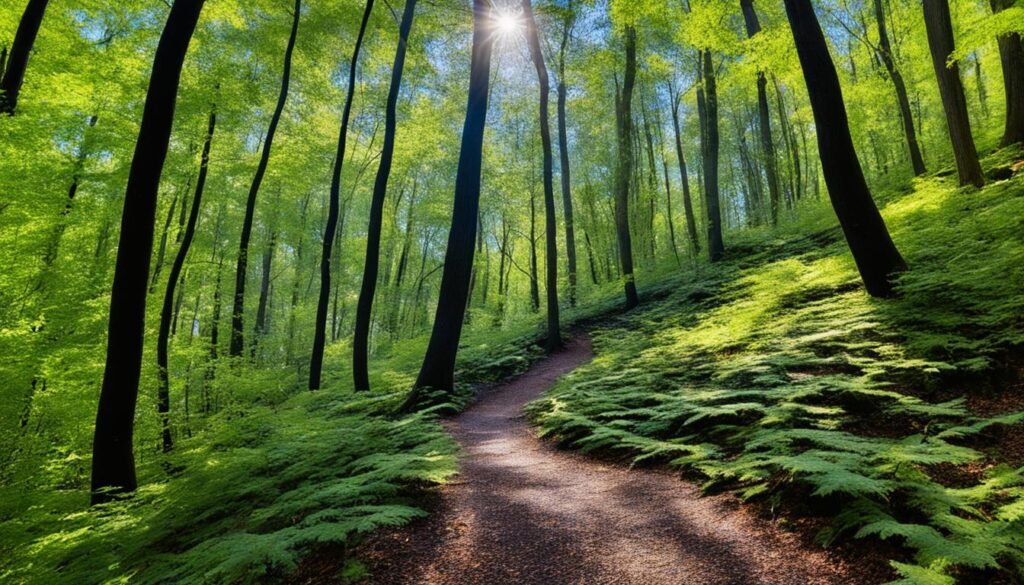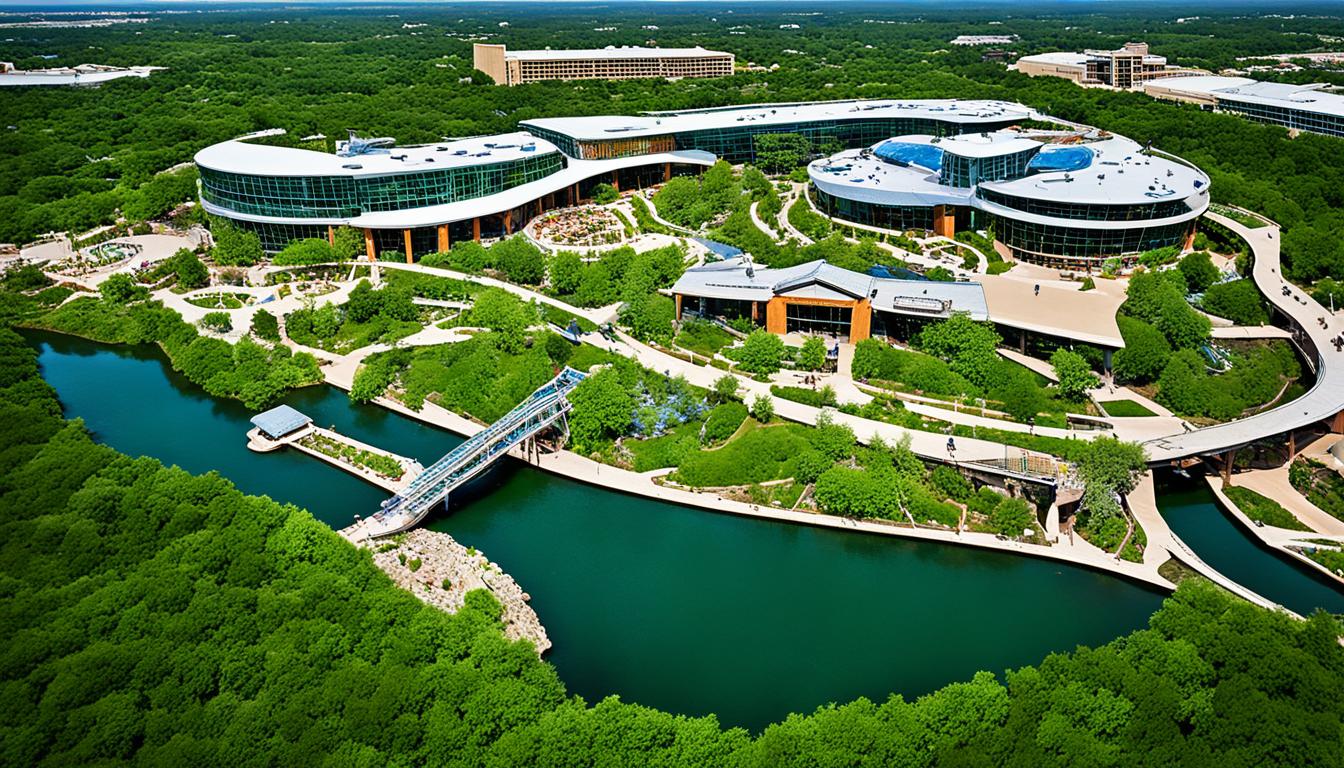Austin Nature and Science Center: Exhibits and Trails
Did you know the Austin Nature & Science Center has a Forest Trail with 45 native trees? It’s on the western edge of Zilker Park. This place isn’t just for native wildlife. It’s a hub for learning and exploring. You’ll find everything from a hands-on Nano Exhibit to a Honey Bee Observation Hive here. The Austin Nature & Science Center (ANSC) brings fun for every age.
Have you seen the Human Sundial at ANSC? You can tell time by your shadow. MathHappens, UTeach, and Austin Parks and Recreation Department worked together on it. There are also Pollinator Gardens for local wildlife. The forest trail shows the best trees for Central Texas.
ANSC has cool art like Arboreal Passage by Colin McIntyre and Big Snake by Kathleen Ash and Elena Eidelberg. And it’s free! This makes learning about nature easy for everyone. They mix education with art beautifully.
Key Takeaways
- The Austin Nature & Science Center features a unique Forest Trail with 45 native trees.
- An inventive Human Sundial allows visitors to tell time using their shadows.
- The Nano Exhibit offers interactive exploration of nano-scale objects.
- The PollBOOSTinator Gardens support native wildlife throughout the year.
- Permanent art installations add an aesthetic dimension to the educational experience.
- Admission to ANSC is free, making it accessible to all visitors.
Exploring the Dino Pit
The Dino Pit at the Austin Nature and Science Center is a unique interactive experience. It’s great for all, especially those interested in paleontology. This dig site was made possible by collaborations with the ANSC, The University of Texas at Austin’s Texas Memorial Museum, the Austin Community Foundation, and Graeber, Simmons & Cowen. It’s a standout spot in Texas for learning about geology and ancient creatures.
Uncover Fossil Treasures
In the Dino Pit, you can find replicas of ancient fossils. This place is much more than a simple sandbox. It’s a space where the history of these fossils is shared. Kids and families get to participate in activities that uncover secrets from Texas’s prehistoric past. The exhibit also dazzles with 19 oil paintings and a large bronze mammoth rib cage at the entrance.
Dinosaur Tracks and Displays
The Dino Pit showcases the variety of dinosaur tracks across Texas. Visitors see realistic displays and trackways, showing where dinosaurs once walked. There’s an observation deck for checking out the site, and displays of fossils from places like the 301 Congress Avenue site. The exhibit includes educational programs for all ages, such as camps, school trips, and teacher workshops. It makes learning about paleontology fun and full.
Many sponsors helped make the Dino GINOsome of these supporters include i2i, Fugro, and the Kodosky Foundation. Their support is crucial for the Dino Pit.
The Dino Pit at ANSC merges art, science, and history in a way that’s engaging. It brings the ancient world to life, inviting people to explore the world of fossils and dinosaur tracks.
Interactive Wildlife Exhibits
The Austin Nature and Science Center (ANSC) has wildlife exhibits focused on interactive learning. The exhibits shed light on local animals and conservation. They let visitors dive deep into the world of wildlife care.

Birds of Prey Area
The Birds of Prey Area is both a showcase and a rescue center for birds in Central Texas. Visitors see majestic raptors and learn about wildlife rehab in Texas. It’s a chance to get close to birds of prey while they get the care they need.
Small Wonders Building
The Small Wonders Building reveals the beauty of tiny creatures in terrariums and aquariums. It highlights small, native species in their natural settings. The exhibit teaches about saving these small but vital animals through interactive learning.
Larger Mammal Enclosures
Larger mammals live in specially designed spaces at ANSC. These animals can’t go back to the wild due to health or behavior problems—visitors learn how important these animal ambassadors are and about wildlife rehab efforts in Texas.
ANSC is dedicated to teaching and conserving wildlife. The Trade Counter Program offers in-depth nature studies from Wednesday to Sunday. The center has over 143 live creatures. Each visit is full of new facts and fun encounters.
The Human Sundial Experience
The Austin Nature & Science Center’s Human Sundial is an amazing exhibit. It was designed by MathHappens and UTeach. Visitors become part of a time-telling device, exploring astronomy and shadow science.
At the exhibit, people stand on stones marked with months. Their shadows match up with different times. It’s one of many interactive exhibits at the center. They make learning about time and space fun and hands-on.
This leads to a deep understanding of timekeeping and the stars. Watching shadows change, people see how the sun moves. It’s both entertaining and enlightening.
This mix makes the sundial popular for both fun and learning. It’s great for teachers and students. The Human Sundial shines during events like solar eclipses. Such occasions let visitors witness celestial effects on Earth.
The sundial is part of the Austin Center’s mission to offer interactive learning. Visitors can explore bee hives or walk through gardens. These experiences help them see nature and science up close.
| Volunteer Season | Application Period | Volunteer Period |
|---|---|---|
| Summer 2023 | April 1-30, 2023 | Late May – Aug 11, 2023 |
| Fall 2023 | August 1-31, 2023 | Early Sep – Dec 8, 2023 (excluding Thanksgiving Week) |
| Spring 2024 | January 1-31, 2024 | Early Feb – May 3, 2024 (excluding Spring Break Week) |
Becoming a volunteer at the center is a chance to help with great exhibits. Volunteers give 9 hours a month over three shifts. They help in special events like the 2023 eclipse. Volunteering offers many rewards.
Discover the Nano Exhibit
The Nano Exhibit is a groundbreaking project backed by the National Science Foundation. It welcomes all ages to explore nanoscale science. Through interactive displays and activities, it shows the unique qualities of nano-objects, like butterfly wing scales.

Hands-on Exploration
At the Austin Nature and Science Center, the Nano Exhibit adds a fun learning dimension. Visitors, especially families, can try out activities. They can build carbon nanotube models, discover magnetic materials, and see nanoscience in action.
Learning About Nano Scale
Created by the NISE Network and funded by the National Science Foundation, this exhibit is key for nano education in museums nationwide. It has become a major part of long-standing exhibits across the country. The exhibit also ties in with NanoDays, creating a comprehensive educational experience.
“The hands-on activities within the Nano Exhibit provide an unparalleled way to grasp nano-scale phenomena, from the intricate details of butterflies wing scales to the vast potential of nanotechnology.”
Fifty copies of the Nano Exhibit will be made and shared with museum partners. This ensures more people can access it. A range of museums across the country will host the exhibit, showing its importance in educating the public about nanoscience.
Walking the Forest Trail
The Forest Trail at the Austin Nature & Science Center is a treat for visitors. It’s a chance to see 45 native trees up close on a self-guided tour. This walk is great for learning about Central Texas landscaping and picking the right trees for it.
If you love learning about nature, you’ll enjoy this trail. There’s lots of info on the native trees as you walk. Signs and fun activities tell you about each tree’s special features and how they help the environment.

This trail makes the place more beautiful and helps nature too. It focuses on local trees. So, it’s good for the animals that live here and for keeping gardening green.
Anyone can take the self-guided tour, moving at their own speed. It’s perfect for families, schools, or anyone who loves nature. The staff keep the trail in top shape, ensuring it’s both fun and safe to explore.
Living here or just visiting, the Forest Trail is a must-see. It shows how important native trees are for Central Texas landscaping. We learn how caring for nature in our yards matters to the bigger picture.
Austin Nature and Science Center Events
The Austin Nature and Science Center (ANSC) is famous for its exciting and educational events. They are made for everyone, from kids to adults. These events help people fall in love with nature and science. They offer many fun activities throughout the year.

Annual Nature Day
The Austin Nature Day is a special event that celebrates the area’s beauty and wildlife. It has educational workshops and nature walks. These help people learn more about the environment. Families can make art inspired by nature or explore geology dig sites, just like the Dino Pit.
Fall Festival and Star Party
The Fall Festival is packed with things to do for families. It includes pumpkin carving and nature games. The Star Party, on the other hand, is an amazing astronomical event. People can look at stars through telescopes and learn about constellations.
Family and Educational Programs
ANSC doesn’t stop at big events. They also have ongoing family events and educational workshops. For example, there are days dedicated to archery and climbing. They teach both fun and safety. There are also classes on chemistry and local wildlife. These focus on birds of prey and tiny insects.
| Event | Focus | Activities |
|---|---|---|
| Austin Nature Day | Local Ecosystem | Guid field Nature Walks, Educational Workshops |
| Fall Festival | Seasonal Celebrations | Pumpkin Carving, Storytelling, Games |
| Star Party | Astronomy | Telescopic Night Sky Viewing, Expert Guides |
Conclusion
The Austin Nature & Science Center (ANSC) is more than just a place to visit. It’s a spot where education meets fun, perfect for families. Since opening in 1960, it has become a key resource for learning about nature. Here, people of all ages can explore natural sciences and get to know the ecosystems of Central Texas.
At ANSC, you can see Texas wildlife up close or dive into activities about plants, ecology, and dinosaurs. There are trails to walk and exhibits that explain the outdoors. The center also reaches out to schools and other groups, helping to spread knowledge about our environment.
ANSC offers programs for different ages, following Texas learning standards. For 2023-2024, all programs with a teacher are booked up, showing how popular it is. Visitors can enjoy trails and events that make learning about nature fun. ANSC helps everyone understand and value the world around us.







